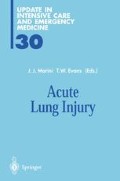Abstract
The response of infants and children to pulmonary injury or inflammatory stim-ulation, like that of the adult, triggers a final common pathway that has come to be known as acute lung injury (ALI). If sufficiently severe, the disorder has been termed acute respiratory distress syndrome (ARDS). In ALI, capillary permeabil-ity to water and large molecules increases. Water and protein leak from pulmo-nary capillary to lung interstitium. The alveolar basement membrane is less permeable to these substances than is the capillary basement membrane, so fluid accumulates in the interstitium of the lung. Pulmonary lymphatics drain the interstitium, and can substantially increase their intrinsic flow rates, but, if this is not sufficient to limit interstitial fluid accumulation, the dam bursts, and intersti-tial fluid and protein begin to leak into alveoli. This liquid impairs surfactant function, raising alveolar surface tension.
Access this chapter
Tax calculation will be finalised at checkout
Purchases are for personal use only
Preview
Unable to display preview. Download preview PDF.
References
Fuhrman BP, Paczan PR, DeFrancisis M (1991) Perfluorocarbon associated gas exchange. Crit Care Med 19: 712 – 723
Hernán LJ, Penili S, Fuhrman BP, et al (1996) Functional Fi02 predicts alveolar p02 during perfluorocarbon associated gas exchange. Crit Care Med 24: A149 (Abst)
Hernán LJ, Fuhrman BP, Kaiser R, et al (1996) Perfluorocarbon associated gas exchange in normal and acid injured large sheep. Crit Care Med 24: 475 – 481
Hernán LJ, Fuhrman BP, Papo MC, Steinhorn DM, Leach CL, Salman N, Paczan P, Kahn B (1995) Cardiopulmonary effects of perfluorocarbon associated gas exchange at reduced oxygen concentrations. Crit Care Med 23: 553 – 559
Salman N, Fuhrman BP, Steinhorn DM, et al (1995) Prolonged studies of perfluorocarbon associated gas exchange and of resumption of conventional mechanical ventilation. Crit Care Med 23: 919 – 924
DeLemos R, Winter D, Fields T, et al (1994) Prolonged partial liquid ventilation in the treatment of hyaline membrane disease (HMD) in the premature baboon. Pediatr Res 35: 330A (Abst)
Tutuncu AS, Faithfull NS, Lachmann B (1993) Comparison of ventilatory support with intratracheal perfluorocarbon administration and conventional mechanical ventilation in animals with acute respiratory failure. Am Rev Respir Dis 148: 785 – 792
Leach CL, Fuhrman BP, Morin FC III, Rath MG (1993) Perfluorocarbon associated gas exchange (PAGE) in respiratory distress syndrome. Crit Care Med 21: 1270 – 1278
Leach CL, Holm B, Morin FCC III, et al (1995) Partial liquid ventilation in premature lambs with respiratory distress syndrome: Efficacy and compatibility with exogenous surfactant. J Pediatr 126: 412 – 210
Wilcox DT, Glick PL, Karamanoukian HL, Morin FC, Fuhrman BP, Leach CL (1995) Perfluorocarbon associated gas exchange improves pulmonary mechanics, oxygenation, ventilation and allows nitric oxide delivery in the hypoplastic lung congenital diaphragmatic hernia lamb model. Crit Care Med 23: 1858 – 1863
Thompson AE, Fuhrman BP, Allen J (1993) Perfluorocarbon associated gas exchange in experimental meconium aspiration. Pediatr Res 33: 239A (Abst)
Papo MC, Paczan P, Fuhrman BP, et al (1996) Perfluorocarbon associated gas exchange improves oxygenation, lung compliance and survival in an animal model of adult respiratory distress syndrome. Crit Care Med 24: 466 – 474
Nesti FD, Fuhrman BP, Steinhorn DM, et al (1994) Perfluorocarbon associated gas exchange (PAGE) in gastric aspiration. Crit Care Med 22: 1445 – 1452
Hirschl RB, Tooley R, Parent AC, Johnson K, Bartlett RH (1995) Improvement of gas exchange, pulmonary function and lung injury with partial liquid ventilation. A study model in a setting of severe respiratory failure. Chest 108: 500 – 508
Smith T, Dandona P, Fuhrman B, Marcucci K, Steinhorn D, Thusu K (1995) A liquid perfluorochemical decreases the in vitro production of reactive oxygen species by alveolar macrophages. Crit Care Med 23: 1533 – 1539
Colton D, Bartlett R, Gill G, Hirschl R, Johnson K (1994) Neutrophil infiltration is reduced during partial perfluorocarbon liquid ventilation in the setting of lung injury. Surg Forum Proc XLV: 668 – 670
Steinhorn DM, Fuhrman BP, Smith T (1995) Liquid perfluorocarbon affects phagocytosis by alveolar macrophages after in vitro exposure. Crit Care Med 23: A213 (Abst)
Steinhorn DM, Fuhrman BP, Smith T (1995) Perflubron decreases nitric oxide production by alveolar macrophages in vitro. Pediatr Res 27: 55A (Abst)
Steinhorn DM, Sajan I (1996) Partial liquid ventilation reduces colonization of the lung during experimental nosocomial pneumonia. Pediatr Res 39: 54A (Abst)
Steinhorn DM, Fuhrman BP, Holm B, Leach C (1996) Partial liquid ventilation enhances surfactant production. Am J Respir Crit Care Med 153: A640 (Abst)
Leach CL, Hernán LJ, Fuhrman BP, Holm B, Morin III F, Papo MC (1995) Partial liquid ventilation with LiquiVent increases endogenous surfactant production in premature lambs with respiratory distress syndrome. Pediatr Res 37 (4 Part 2 ): 238A (Abst)
Leach CL, Greenspan JS, Rubenstein SD, et al (1996) Partial liquid ventilation with perflubron in fremature infants with severe respiratory distress syndrome. N Engl J Med 335: 761 – 767
Toro—Figueroa L, Curtis S, Fackler J, et al (1996) Perflubron partial liquid ventilation (PLV) in children with ARDS. A safety and efficacy pilot study. Crit Care Med 24: A150 (Abst)
Editor information
Editors and Affiliations
Rights and permissions
Copyright information
© 1998 Springer-Verlag Berlin Heidelberg
About this paper
Cite this paper
Fuhrman, B.P. (1998). Perfluorocarbon Liquid Ventilation in Pediatric ALI. In: Marini, J.J., Evans, T.W. (eds) Acute Lung Injury. Update in Intensive Care and Emergency Medicine, vol 30. Springer, Berlin, Heidelberg. https://doi.org/10.1007/978-3-642-60733-2_19
Download citation
DOI: https://doi.org/10.1007/978-3-642-60733-2_19
Publisher Name: Springer, Berlin, Heidelberg
Print ISBN: 978-3-642-64532-7
Online ISBN: 978-3-642-60733-2
eBook Packages: Springer Book Archive

